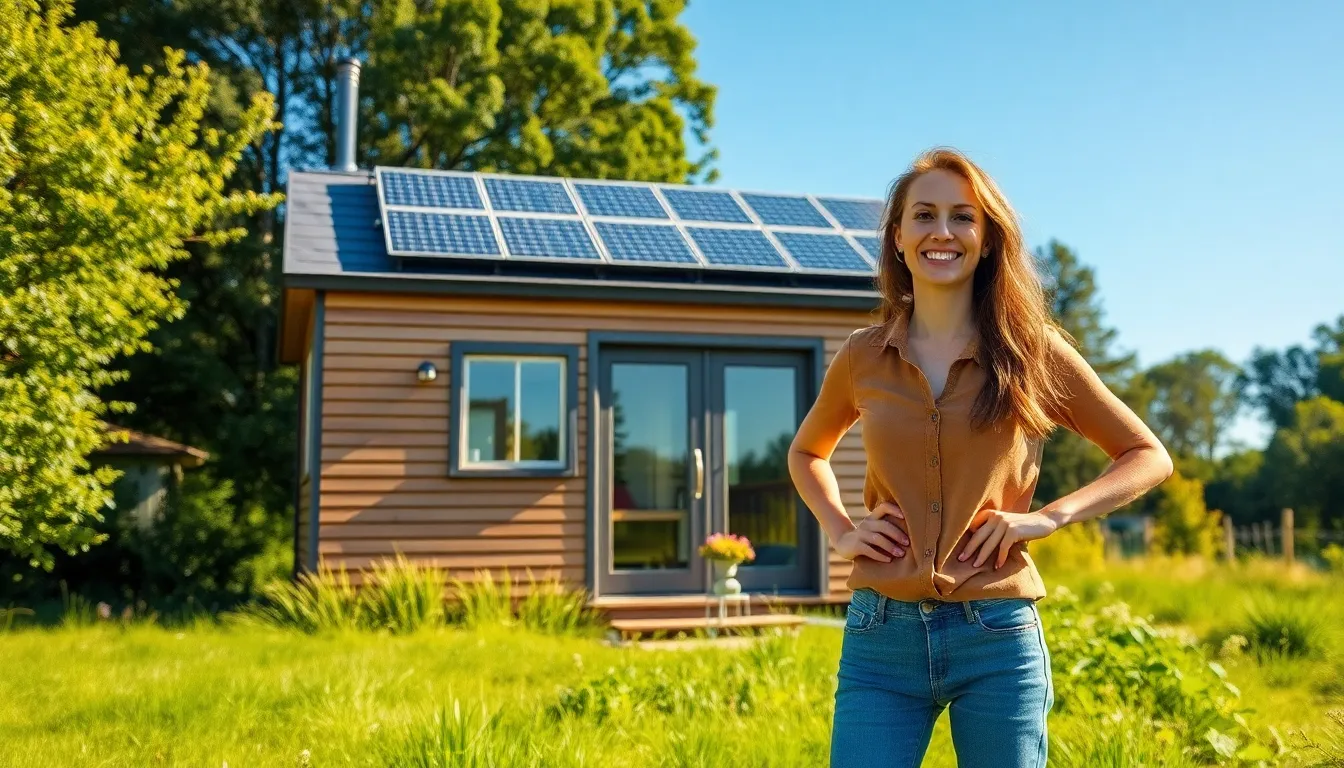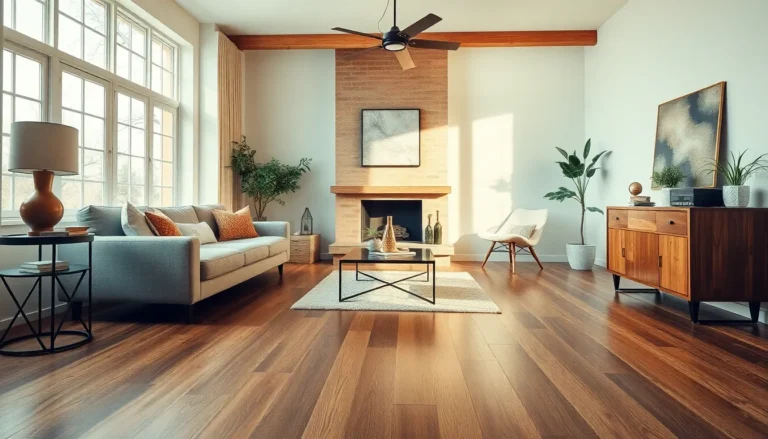Table of Contents
ToggleTiny homes are taking the world by storm, and for good reason. Who wouldn’t want to live in a cozy space that feels like a stylish treehouse? These pint-sized abodes pack a punch with innovative designs and eco-friendly features, making them the perfect solution for anyone looking to downsize or embrace a minimalist lifestyle.
Overview of Tiny Homes
Tiny homes serve as a trendy solution for those seeking a minimalist lifestyle. The average tiny home ranges from 100 to 400 square feet, offering functional living in a compact space. Many incorporate innovative storage solutions that maximize utility without sacrificing comfort.
Various designs cater to different tastes, from modern aesthetics to rustic charm. Popular features include open floor plans, large windows for natural light, and eco-friendly materials. These homes often utilize energy-efficient appliances, further enhancing their appeal to environmentally conscious individuals.
Homeowners experience numerous financial benefits through tiny living. Lower mortgage costs, reduced utility bills, and minimal maintenance expenses contribute to long-term savings. Many tiny homes also encourage residents to declutter, promoting a simpler, more organized lifestyle.
Communities focused on tiny living are emerging across the country. These neighborhoods often promote shared resources, fostering connections among residents. Tiny home communities can include shared gardens, recreational areas, and communal facilities, enriching the living experience.
Regulations governing tiny homes differ by location. Zoning laws may impact where these homes can be placed, influencing design choices and mobility. Prospective buyers must research local requirements to ensure compliance.
Further appealing is the mobility of many tiny homes. Some are built on trailers, making relocation straightforward. This flexibility allows residents to adapt their living situations based on personal preferences or job opportunities.
Benefits of Tiny Living

Tiny living offers numerous advantages that attract many individuals to this lifestyle choice.
Financial Savings
Lower mortgage costs appeal to those who seek financial relief. Reduced utility bills further enhance the affordability of tiny homes. Minimal maintenance expenses also contribute to long-term savings. For example, homeowners frequently save up to 75% on energy costs compared to traditional houses. Smaller spaces mean fewer repairs and upkeep, making living simpler and more cost-effective. Many tiny homeowners use these savings to invest in experiences or travel, prioritizing enjoyment over possessions. Overall, tiny living fosters greater financial freedom and stability.
Environmental Impact
Tiny homes encourage sustainable living through their smaller footprints. Energy-efficient appliances designed for these spaces minimize overall energy consumption. Many tiny homes incorporate solar panels, reducing reliance on traditional energy sources. Studies indicate that tiny homes can produce up to 60% less carbon emissions than average-sized homes. Smaller water usage decreases the demand on local resources, which supports a healthier ecosystem. Homeowners frequently adopt eco-friendly practices that align with their living choices, promoting environmental responsibility. Embracing tiny living ultimately leads to a more sustainable future for individuals and communities.
Types of Tiny Homes
Tiny homes come in various types, each catering to different preferences and lifestyles. Understanding these types helps individuals choose a living situation that fits their needs.
Mobile Tiny Homes
Mobile tiny homes offer flexibility, allowing residents to change their surroundings easily. Built on trailers, these homes can be towed to different locations. They appeal to those who value mobility or want to travel while enjoying the comforts of home. Many designs maximize space efficiency, incorporating clever storage solutions and multi-functional furniture. The ability to relocate adds a layer of adventure to tiny living, fostering an exciting lifestyle for individuals who embrace change.
Stationary Tiny Homes
Stationary tiny homes maintain a permanent foundation, offering stability and a sense of community. These homes often reside in designated tiny home communities or on private land. Residents enjoy the benefits of a fixed address and the opportunity to personalize their space. With various designs available, stationary tiny homes can range from modern chic to rustic charm, adapting to individual tastes. Energy-efficient features in these homes support sustainability efforts, while lower maintenance provides more time for leisure activities and community engagement.
Popular Tiny Home Brands
Numerous brands specialize in tiny homes, offering unique designs and features that resonate with various lifestyles. Here are two standout options available in the market today.
Brand A Review
Brand A specializes in modern tiny homes, featuring innovative designs that optimize space and functionality. Customers appreciate the large windows that allow natural light to fill the interior, creating a bright and welcoming atmosphere. Some models include eco-friendly materials and energy-efficient appliances, promoting sustainability. Buyers often highlight the flexibility in customizing layouts to suit individual preferences. Pricing typically ranges from $30,000 to $70,000, making it accessible for many looking to downsize. Overall, Brand A’s commitment to quality construction and stylish design earns it a favorable reputation in the tiny home community.
Brand B Review
Brand B is known for its rustic-style tiny homes, featuring charming aesthetics that blend with natural surroundings. Many customers find the use of reclaimed wood and vintage finishes appealing, adding character to each home. The efficient floor plans maximize livable space while maintaining a cozy feel. With prices averaging from $40,000 to $80,000, it remains a viable option for budget-conscious individuals. In addition, Brand B offers a variety of models, making it easy for potential homeowners to find their perfect fit. This brand’s focus on craftsmanship and sustainability resonates with those seeking a unique living experience.
Factors to Consider Before Buying
Tiny homes present unique considerations for prospective buyers. Evaluating personal lifestyle preferences and needs remains essential in this journey.
Space and Layout
Space greatly influences the comfort of living in a tiny home. Compact designs often utilize clever layouts, optimizing square footage without sacrificing functionality. Homeowners typically enjoy open floor plans that enhance visibility and create an airy feel. Many designs include multi-functional furniture, like convertible sofas or foldable tables, promoting flexibility in small spaces. Thoughtful storage solutions maximize every inch, often appearing in unexpected places, like under stairs or built into walls. Personalizing these areas fosters a sense of home within limited confines, making it feasible for large families or individuals embarking on solo living to thrive in tiny homes.
Legal Regulations
Legal regulations can vary significantly depending on location. Zoning laws and building codes, existing in many areas, dictate whether tiny homes can be placed on properties. Some regions embrace tiny homes, while others pose challenges, restricting the types of dwellings permitted. It’s crucial to verify local ordinances before making a purchase decision. Understanding whether tiny homes require permanent foundations or can remain mobile plays a vital role in planning. Some communities even encourage tiny living through designated spaces, while others might not allow tiny homes at all. Assessing these regulations helps prevent future complications in ownership, ensuring that buyers make informed choices.
Tiny homes represent a transformative shift in how individuals approach living spaces. With their innovative designs and eco-friendly features they offer a unique blend of comfort and sustainability. As more people embrace minimalist lifestyles the appeal of tiny homes continues to grow.
The financial benefits are significant allowing homeowners to enjoy lower costs and reduced environmental impact. Whether opting for a mobile or stationary tiny home each choice caters to diverse lifestyles and preferences.
As tiny home communities emerge across the country they foster connections and promote shared values of sustainability. For those considering this lifestyle it’s essential to understand local regulations and personal needs to ensure a fulfilling tiny living experience. Tiny homes are not just a trend but a movement towards a simpler and more responsible way of living.







